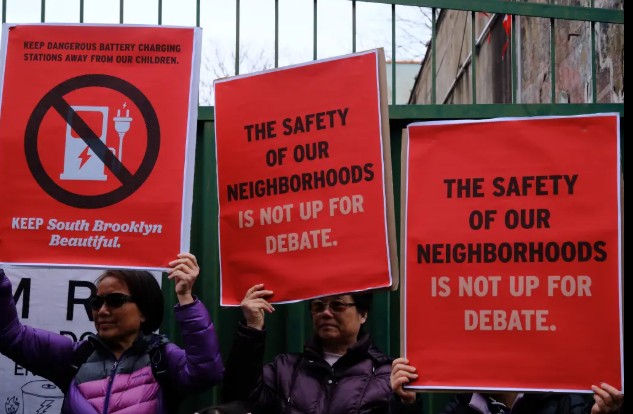In a growing backlash against New York’s ambitious green energy agenda, residents across the state are rallying against the proliferation of massive battery energy storage systems (BESS). These facilities, intended to support the state’s transition to renewable energy, have sparked concerns over safety risks, particularly from lithium-ion battery fires that could release toxic emissions and contaminate local water sources. Now, this opposition has gained a powerful ally in EPA Administrator Lee Zeldin, who is stepping in to highlight the environmental hazards associated with these projects.
The controversy centers on proposed BESS facilities in areas like Hauppauge on Long Island, where locals fear that fires could discharge pollutants such as hydrofluoric acid into the Nissequogue River and groundwater. Similar protests have erupted in Brooklyn, Staten Island, Queens, the Hudson Valley, and upstate New York. Residents point to incidents in California and Hawaii, where BESS fires caused significant damage, as evidence of the dangers. Despite New York’s recent enactment of stringent regulations for BESS development—praised by former FDNY officials like Commissioner Tom Von Essen—the pushback persists, with communities arguing that the state’s climate goals are prioritizing ideology over safety.
Are you from California, New Jersey or New York and need a tax break?
Enter Lee Zeldin, the former Long Island congressman and 2022 Republican gubernatorial candidate, now serving as EPA chief. On August 18, 2025, Zeldin held a press conference in Hauppauge to address these issues, announcing new EPA guidance for communities on the environmental risks of BESS facilities. While not outright opposing the technology, Zeldin emphasized that labeling something “green energy” doesn’t eliminate its impacts. “Calling a technology ‘green energy’ does not mean there are no environmental impacts,” he stated. He further criticized New York’s Democratic leadership, including Gov. Kathy Hochul, for pursuing “delusional” goals under the 2019 Climate Leadership and Community Protection Act, which mandates a 40% reduction in greenhouse gas emissions by 2030 and 100% zero-carbon electricity by 2040.
Zeldin lambasted policies restricting natural gas usage, saying, “The state that banned the safe extraction of natural gas, gas hook-ups on new construction, gas stoves, and aims to end the sale of gas-powered vehicles, continues to put the safety and well-being of New Yorkers second to their climate change agenda.” He highlighted residents’ fears, noting, “Residents are looking across the country where dangerous lithium battery fires at BESS facilities have caused widespread damage, and they are concerned with New York’s partisan push to fill yet another of its delusional ‘green’ goals, which the state itself admits it cannot meet.”
Hochul’s office fired back, with senior advisor Ken Lovett accusing Zeldin of undermining environmental protection and potentially harming the state’s economy and energy independence. Despite the tension, New York has already approved over 6,000 battery storage projects since 2019, creating 440 megawatts of capacity, with a goal of 6 gigawatts by 2030. Recent laws even allow the state to override local opposition for larger projects, though the Hauppauge facility falls outside this provision.
New York’s Energy Mix: A Snapshot Amid Transition
This debate unfolds against the backdrop of New York’s evolving energy landscape, driven by mandates for 70% renewable electricity by 2030 and 100% carbon-free power by 2040. According to the latest data from the U.S. Energy Information Administration (EIA) for 2023, natural gas remains the dominant source, accounting for 46% of the state’s net electricity generation. Nuclear power follows at 22%, providing a stable, low-carbon baseload. Hydroelectric power, primarily from in-state and imported Quebec sources, contributes another 22%.
Renewables are growing but still represent a smaller share: Wind makes up 4%, solar 5%, and biomass 1%. Petroleum liquids add a negligible 0.3%, while coal-fired generation has been phased out entirely, with no utility-scale coal plants operating in 2023. This mix reflects New York’s progress toward decarbonization, with over 30% from zero-emission sources like nuclear and hydro, but it also underscores reliance on natural gas for reliability during peak demand.
Projections indicate a rapid scale-up of renewables, including at least 9,000 megawatts of offshore wind by 2035. However, challenges like supply chain issues and technological gaps for dispatchable emission-free resources (such as advanced batteries or hydrogen) could delay these targets, potentially requiring extensions for existing fossil fuel plants to maintain grid stability.
High Energy Costs: Where New York Ranks Nationally
New York’s aggressive green push comes at a price, with residents facing some of the highest electricity rates in the nation. As of August 2025, the state’s average residential electricity rate stands at 26.67 cents per kilowatt-hour (kWh), marking a 13% increase from the previous year. This places New York seventh among the top 10 states with the highest rates, behind Hawaii (41.03 ¢/kWh), California (35.03 ¢/kWh), Connecticut (31.64 ¢/kWh), Massachusetts (29.94 ¢/kWh), Rhode Island (29.00 ¢/kWh), and Maine (27.91 ¢/kWh).
In comparison, the national average residential rate is 17.47 ¢/kWh, up 6.5% year-over-year. New York’s elevated costs are attributed to factors like high transmission fees, taxes, and investments in renewable infrastructure, which critics argue exacerbate affordability issues for households already grappling with the state’s high cost of living.
Implications for New York’s Energy Future
Zeldin’s intervention highlights a broader tension in New York’s energy policy: balancing ambitious climate targets with community safety and economic realities. As the state ramps up BESS deployments to store intermittent renewable energy, addressing fire risks and environmental concerns will be crucial. With natural gas still powering nearly half the grid and costs soaring, policymakers face pressure to ensure the transition doesn’t leave residents in the dark—literally or figuratively. The coming months could see intensified debates, potentially influencing national discussions on green energy deployment.
Is Oil & Gas Right for Your Portfolio?
Crude Oil, LNG, Jet Fuel price quote
ENB Top News
ENB
Energy Dashboard
ENB Podcast
ENB Substack

